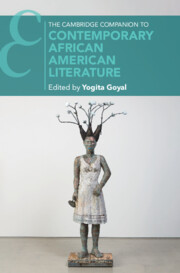Book contents
- The Cambridge Companion to Contemporary African American Literature
- The Cambridge Companion to Contemporary African American Literature
- Copyright page
- Contents
- Contributors
- Acknowledgments
- Chronology
- Introduction
- Part I Histories of the Present
- Part II African American Genres
- 4 Afrofuturism and the Speculative Turn
- 5 The Black Lyric
- 6 Neo-Slave Imaginaries
- 7 Incarceration and Confinement Literature
- 8 Satire, Comedy, and Critique
- 9 Popular Romance and Literary Undergrounds
- Part III Mapping New Identities and Geographies
- Part IV Critical Approaches
- Further Reading
- Index
- Cambridge Companions To …
7 - Incarceration and Confinement Literature
from Part II - African American Genres
Published online by Cambridge University Press: 14 December 2023
- The Cambridge Companion to Contemporary African American Literature
- The Cambridge Companion to Contemporary African American Literature
- Copyright page
- Contents
- Contributors
- Acknowledgments
- Chronology
- Introduction
- Part I Histories of the Present
- Part II African American Genres
- 4 Afrofuturism and the Speculative Turn
- 5 The Black Lyric
- 6 Neo-Slave Imaginaries
- 7 Incarceration and Confinement Literature
- 8 Satire, Comedy, and Critique
- 9 Popular Romance and Literary Undergrounds
- Part III Mapping New Identities and Geographies
- Part IV Critical Approaches
- Further Reading
- Index
- Cambridge Companions To …
Summary
This chapter traces the emergence of African American confinement literature in the contemporary African American literary tradition over the past six decades, paying careful attention to the subfield’s examination of racialized and gendered confinement in spaces that include but also extend beyond the carceral geographies of jail and prison. Highlighting the centrality of the literary work of former political prisoner and prison abolitionist Angela Y. Davis to the origins and development of this subfield, this chapter demonstrates how works of African American confinement literature fundamentally eclipse the narrow categorization of “prison writing.” These works explore confinement as both a complicated metaphor for and a recurring lived experience within socially and psychically constricting systems of anti-Black racism, gendered social control, racialized economic exploitation, political repression, and incarceration. In sum, authors of contemporary African American confinement literature draw compelling parallels between the confining racist and sexist institutions and practices from previous eras – such as slavery, the convict lease system, chain gang camps, peonage, lynching, and Jim Crow – and those that persist in the contemporary US carceral state, including racial profiling, state violence, prisoner abuse, policing, and the prison-industrial complex.
Keywords
- Type
- Chapter
- Information
- Publisher: Cambridge University PressPrint publication year: 2023



